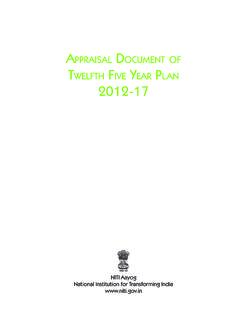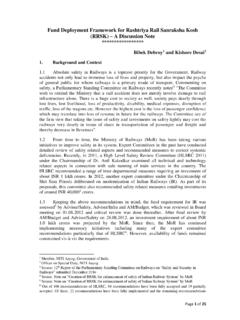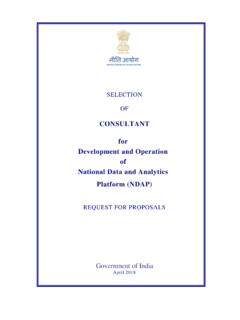Transcription of HEALTH CARE IN INDIA - VISION 2020 ISSUES AND …
1 HEALTH CARE IN INDIA - VISION 2020 ISSUES AND PROSPECTS R. Srinivisan INTRODUCTION Key linkages in HEALTH HEALTH and HEALTH care need to be distinguished from each other for no better reason than that the former is often incorrectly seen as a direct function of the latter. Heath is clearly not the mere absence of disease. Good HEALTH confers on a person or groups freedom from illness - and the ability to realize one's potential. HEALTH is therefore best understood as the indispensable basis for defining a person's sense of well being. The HEALTH of populations is a distinct key issue in public policy discourse in every mature society often determining the deployment of huge society. They include its cultural understanding of ill HEALTH and well-being, extent of socio-economic disparities, reach of HEALTH services and quality and costs of care. and current bio-mcdical understanding about HEALTH and illness.
2 HEALTH care covers not merely medical care but also all aspects pro preventive care too. Nor can it be limited to care rendered by or financed out of public expenditure- within the government sector alone but must include incentives and disincentives for self care and care paid for by private citizens to get over ill HEALTH . Where, as in INDIA , private out-of-pocket expenditure dominates the cost financing HEALTH care, the effects are bound t be regressive. Heath care at its essential core is widely recognized to be a public good. Its demand and supply cannot therefore, be left to be regulated solely by the invisible had of the market. Nor can it be established on considerations of utility maximizing conduct alone. What makes for a just HEALTH care system even as an ideal? Four criteria could be suggested- First universal access, and access to an adequate level, and access without excessive burden. Second fair distribution of financial costs for access and fair distribution of burden in rationing care and capacity and a constant search for improvement to a more just system.
3 Third training providers for competence empathy and accountability, pursuit of quality care ad cost effective use of the results of relevant research. Last special attention to vulnerable groups such a children, women, disabled and the aged. Forecasting in HEALTH Sector In general predictions about future HEALTH - of individuals and populations - can be notoriously uncertain. However all projections of HEALTH care in INDIA must in the end rest on the overall changes in its political economy - on progress made in poverty mitigation ( HEALTH care to the poor) in reduction of inequalities ( HEALTH inequalities affecting access/quality'), in generation of employment /income streams (to facilitate capacity to pay and to accept individual responsibility for one's HEALTH ). in public information and development communication (to promote preventive self care and risk reduction by conducive life styles ) and in personal life style changes (often directly resulting from social changes and global influences).
4 Of course it will also depend on progress in reducing mortality and the likely disease load, efficient and fair delivery and financing systems in private and public sectors and attention to vulnerable sections- family planning and nutritional services and women's empowerment and the confirmed interest of me siat-e 10 ensure just HEALTH care to the Largest extent possible. To list them is to recall that Indian planning had at its best attempted to capture this synergistic approach within a democrat ic structure. It is another matter that it is now remembered only for its mixed success. Available HEALTH forecasts There is a forecast on the new HEALTH challenges likely to emerge in INDIA over tne next few decades. Murry and Lopez <WorId Bank B 2000> have provided a possible scenario of the burden of disease (BOD) for INDIA in the year 2020, based on a statistical model calculating the change in DALYS are applied to the population projections for 2020 and conversely.
5 The key conclusions must be understood keeping in the mind the tact that the concept of DALYs incorporates not only mortality but disability viewed in terms of healthy years of life lost. In this forecast, DALYs are expected to dramatically decrease in respect of diarrhoeal diseases and respiratory infections and less dramatically for maternal conditions. TB is expected to plateau by 2000, and HIV infections are expected to rise significantly up to 2010. Injuries may increase less significantly, the proportion of people above 65 will increase and as a result the burden of non-communicable disease will rise. Finally cardiovascular diseases resulting any from the risk associated with smoking urban stress and improper diet are expected to increase dramatically. Under the same BOD methodology another view is available from a four - state analysis done in 1996 <World Bank B 2000> these four states - AP, Kamataka, W.
6 Bengal and Punjab - represent different stages in the Indian HEALTH transition. The analysis reveals that the poorer and more populated states. West Bengal, will still face a large incidence of communicable diseases. More prosperous states, such as Punjab further along the HEALTH transiting will witness sharply increasing incidence of non-communicable diseases especially, in urban areas. The projections highlight that we still operating on unreliable or incomplete base data on mortality and causes of death in the absence of vital registration statistics and know as yet little about how they differ between social classes and regions or about the dynamic patterns of change at work. It also highlights the policy dilemma of how to balance between the articulate middle upper class demand for more access to technologically advanced and subsidized clinical services and the more pressing needs of the poor for coverage of basic disease control interventions.
7 This conflict over deployment of public resources will only get exacerbated in future. What matters most in such estimates are not societal averages with respect to HEALTH but sound data illumining specifically the HEALTH conditions of the disadvantaged in local areas <Gwatkin A 2000> that long tradition of HEALTH sector analysis looking at unequal access, income poverty and unjustly distributed resources as the trigger to meet HEALTH needs of the poor. That tradition has been totally replaced by the currently dominant school of international thought about HEALTH which is concerned primarily with efficiency of systems measured by cost effectiveness criteria. Future of State Provided HEALTH Care Historically the Indian commitment to HEALTH development has been guided by two principles-with three consequences. The first principle was State responsibility for HEALTH care and the second (after independence) was free medical care for all (and not merely to those unable to pay), The first set of consequences was inadequate priority to public HEALTH , poor investment in safe water and samtati on and to the neglect of the key role of personal hygiene in good HEALTH , culminating in the persistence of diseases like Cholera.
8 The second set of consequences pertains to substantially unrealized goals of NHP 1983 due to funding difficulties from compression of public expenditures and from organizational inadequacies. The ambitious and far reaching NPP - 2000 goals and strategies have however been formulated on that edifice in the hope that the gaps and the inadequate would be removed by purposeful action. Without being too defensive or critical about its past failures, the rural HEALTH structure should be strengthened and funded and managed efficiently in all States by 2005. This can trigger many dramatically changes over the next twenty years in neglected aspects or rural HEALTH and of vulnerable segments. The third set of consequences appears to be the inability to develop and integrate plural systems of medicine and the failure to assign practical roles to the private sector and to assign public duties for private professionals. To set right these gaps demanded patient redefinition of the state's role keeping the focus on equity.
9 But during the last decade there has been an abrupt switch to market based governance styles and much influential advocacy to reduce the state role in HEALTH in order to enforce overall compression of public expenditure an reduce fiscal deficits. People have therefore been forced to switch between weak and efficient public services and expensive private provision or at the limit forego care entirely except in life threatening situations, in such cases sliding into indebtedness. HEALTH status of any population is not only the record of mortality and its morbidity profile but also a record of its resilience based on mutual solidarity and indigenous traditions of self-care - assets normally invisible to he planner and the professional. Such resilience can be enriched with the State retaining a strategic directional role for the good HEALTH of all its citizens in accordance with the constitutional mandate. Within such a framework alone can the private sector be engaged as an additional instrument or a partner for achieving shared public HEALTH outcomes.
10 Similarly, in indigenous HEALTH systems must be promoted to the extent possible to become another credible delivery mechanism in which people have faith and away fond for the vat number of less than folly qualified doctore in rural areas to get skills upgraded. Public programs in rural and poor urban areas engaging indigenous practitioners and community volunteers can prevent much seasonal and communicable disease using low cost traditional knowledge and based on the balance between food, exercise medicine and moderate living. Such an overall VISION of the public role of the heterogenous private sector must inform the course of future of state led HEALTH care in the country. KEY ACHIEVEMENTS IN HEALTH Our overall achievement in regard to longevity and other key HEALTH indicators are impressive but in many respects uneven across States, The two Data Annexure at the end indicate selected HEALTH demographic and economic indicators and highlight the changes between 1951and 2001.















